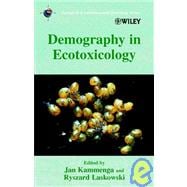
Note: Supplemental materials are not guaranteed with Rental or Used book purchases.
Purchase Benefits
What is included with this book?
Jan Kammenga and Ryszard Laskowski are the authors of Demography in Ecotoxicology, published by Wiley.
|
xi | ||||
| Series Foreword | xv | ||||
| Preface | xvii | ||||
| PART ONE INTRODUCTION | 1 | (24) | |||
|
3 | (6) | |||
|
|||||
|
|||||
|
3 | (6) | |||
|
9 | (16) | |||
|
|||||
|
|||||
|
9 | (1) | |||
|
10 | (1) | |||
|
11 | (3) | |||
|
14 | (1) | |||
|
15 | (5) | |||
|
20 | (5) | |||
| PART TWO DEMOGRAPHIC APPROACHES | 25 | (102) | |||
|
27 | (16) | |||
|
|||||
|
|||||
|
27 | (1) | |||
|
28 | (5) | |||
|
33 | (6) | |||
|
39 | (1) | |||
|
40 | (3) | |||
|
43 | (14) | |||
|
|||||
|
43 | (2) | |||
|
45 | (7) | |||
|
52 | (5) | |||
|
57 | (16) | |||
|
|||||
|
57 | (1) | |||
|
57 | (2) | |||
|
59 | (7) | |||
|
66 | (4) | |||
|
70 | (3) | |||
|
73 | (18) | |||
|
|||||
|
|||||
|
|||||
|
|||||
|
73 | (2) | |||
|
75 | (9) | |||
|
84 | (2) | |||
|
86 | (5) | |||
|
89 | (2) | |||
|
91 | (22) | |||
|
|||||
|
91 | (2) | |||
|
93 | (8) | |||
|
101 | (7) | |||
|
108 | (5) | |||
|
113 | (14) | |||
|
|||||
|
|||||
|
|||||
|
113 | (2) | |||
|
115 | (6) | |||
|
121 | (1) | |||
|
122 | (5) | |||
| PART THREE EVOLUTION IN POLLUTED ENVIRONMENTS | 127 | (90) | |||
|
129 | (18) | |||
|
|||||
|
|||||
|
129 | (1) | |||
|
130 | (2) | |||
|
132 | (2) | |||
|
134 | (4) | |||
|
138 | (1) | |||
|
139 | (3) | |||
|
142 | (5) | |||
|
147 | (16) | |||
|
|||||
|
|||||
|
147 | (3) | |||
|
150 | (3) | |||
|
153 | (3) | |||
|
156 | (2) | |||
|
158 | (5) | |||
|
163 | (16) | |||
|
|||||
|
|||||
|
|||||
|
163 | (2) | |||
|
165 | (1) | |||
|
166 | (2) | |||
|
168 | (5) | |||
|
173 | (2) | |||
|
175 | (4) | |||
|
177 | (2) | |||
|
179 | (20) | |||
|
|||||
|
|||||
|
|||||
|
179 | (2) | |||
|
181 | (5) | |||
|
186 | (7) | |||
|
193 | (6) | |||
|
199 | (18) | |||
|
|||||
|
199 | (1) | |||
|
200 | (2) | |||
|
202 | (6) | |||
|
208 | (3) | |||
|
211 | (6) | |||
| PART FOUR VALIDITY AND LINKS BETWEEN BIOCHEMISTRY, PHYSIOLOGY AND DEMOGRAPHY | 217 | (46) | |||
|
219 | (22) | |||
|
|||||
|
219 | (1) | |||
|
220 | (1) | |||
|
221 | (2) | |||
|
223 | (5) | |||
|
228 | (3) | |||
|
231 | (1) | |||
|
232 | (1) | |||
|
233 | (8) | |||
|
241 | (22) | |||
|
|||||
|
241 | (1) | |||
|
242 | (8) | |||
|
250 | (3) | |||
|
253 | (1) | |||
|
254 | (1) | |||
|
255 | (8) | |||
| PART FIVE OPEN PROBLEMS AND RECOMMENDATIONS FOR RISK ASSESSMENT | 263 | (24) | |||
|
265 | (12) | |||
|
|||||
|
|||||
|
265 | (1) | |||
|
265 | (2) | |||
|
267 | (3) | |||
|
270 | (3) | |||
|
273 | (4) | |||
|
277 | (10) | |||
|
|||||
|
277 | (2) | |||
|
279 | (1) | |||
|
280 | (2) | |||
|
282 | (1) | |||
|
282 | (1) | |||
|
283 | (4) | |||
| Index | 287 |
The New copy of this book will include any supplemental materials advertised. Please check the title of the book to determine if it should include any access cards, study guides, lab manuals, CDs, etc.
The Used, Rental and eBook copies of this book are not guaranteed to include any supplemental materials. Typically, only the book itself is included. This is true even if the title states it includes any access cards, study guides, lab manuals, CDs, etc.